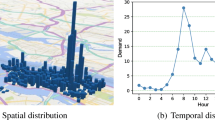Abstract
With the rapid growth of bike-sharing comes the challenge of unregulated bike-sharing parking in cities, which can lead to an unbalanced distribution of bikes and negatively impact the user experience and the operating costs of bike-sharing companies. To address these challenges, bike-sharing companies can create temporary parking stations or electronic fencing and implement bicycle rebalancing strategies across districts. However, these strategies require real-time data analysis and should take into account other factors, such as the inflow and outflow of bikes in each zone. To solve this problem, we proposes a composite clustering algorithm based on density and inflow-outflow balance to divide the city into a grid and extract hotspots as suitable areas for bicycle docking stations. Comparative experiments on common clustering algorithms for shared bicycles demonstrate the reasonableness and high precision of our method.
Access this chapter
Tax calculation will be finalised at checkout
Purchases are for personal use only
Similar content being viewed by others
References
Wang, H., Chen, X.J., Wang, Y., et al.: Local maximum density approach for small-scale clustering of urban taxi stops. International Archives of the Photogrammetry, Remote Sensing and Spatial Information Sciences, vol. 42(2/W13) (2019)
MacQueen, J.: Classification and analysis of multivariate observations. In: 5th Berkeley Symposium on Mathematical Statistics and Probability. Los Angeles LA USA: University of California, pp. 281–297 (1967)
Ester, M., Kriegel, H.P., Sander, J., et al.: A density-based algorithm for discovering clusters in large spatial databases with noise. KDD 96(34), 226–231 (1996)
Ankerst, M., Breunig, M.M., Kriegel, H.P., et al.: OPTICS: ordering points to identify the clustering structure. ACM SIGMOD Rec. 28(2), 49–60 (1999)
Campello, R.J.G.B., Moulavi, D., Sander, J.: Density-based clustering based on hierarchical density estimates. In: Pei, J., Tseng, V.S., Cao, L., Motoda, H., Xu, G. (eds.) PAKDD 2013. LNCS (LNAI), vol. 7819, pp. 160–172. Springer, Heidelberg (2013). https://doi.org/10.1007/978-3-642-37456-2_14
Dockhorn, A., Braune, C., Kruse, R.: An alternating optimization approach based on hierarchical adaptations of DBSCAN. In: 2015 IEEE Symposium Series on Computational Intelligence, pp. 749–755. IEEE (2015)
Wang, W., Yang, J., Muntz, R.: STING: a statistical information grid approach to spatial data mining. VLDB 97, 186–195 (1997)
Sheikholeslami, G., Chatterjee, S., Zhang, A.: WaveCluster: a multi-resolution clustering approach for very large spatial databases. VLDB 98, 428–439 (1998)
Agrawal, R., Gehrke, J., Gunopulos, D., et al.: Automatic subspace clustering of high dimensional data for data mining applications. Proceed. ACM SIGMOD Int. Conf. Manag. Data 1998, 94–105 (1998)
Zhaohua, C.: Improvement and application of cluster analysis algorithm CLIQUE. Central South University, Changsha (2009)
Wu, X., Zurita-Milla, R., Kraak, M.J., et al.: Clustering-based approaches to the exploration of spatio-temporal data. Int. Arch. Photogramm. Remote Sens. Spatial Inf. Sci. 42, 1387–1391 (2017)
Changzheng, X., Fei, W., Lili, W.: Density grid-based data stream clustering algorithm with parameter automatization. J. Front. Comput. Sci. Technol. 5(10), 953 (2011)
Oleinikova, S.A., Kravets, O.J., Silnov, D.S.: Analytical estimates for the expectation of the beta distribution on the basis of the known values of the variance and mode. International Information Institute (Tokyo). Inf. 19(2), 343 (2016)
Cai, Z., Ji, M., Mi, Q., et al.: Dynamic grid-based spatial density visualization and rail transit station prediction. ISPRS Int. J. Geo Inf. 10(12), 804 (2021)
Ashbrook, D., Starner, T.: Using GPS to learn significant locations and predict movement across multiple users. Pers. Ubiquit. Comput. 7, 275–286 (2003)
Yaohui, L., Zhengming, M., Fang, Y.: Adaptive density peak clustering based on K-nearest neighbors with aggregating strategy. Knowl.-Based Syst. 133, 208–220 (2017)
Cai, Z., Wang, J., Li, T., et al.: A novel trajectory based prediction method for urban subway design. ISPRS Int. J. Geo-Inf. 11(2), 126 (2022)
Author information
Authors and Affiliations
Corresponding author
Editor information
Editors and Affiliations
Rights and permissions
Copyright information
© 2023 The Author(s), under exclusive license to Springer Nature Switzerland AG
About this paper
Cite this paper
Guo, L., Li, D., Cai, Z. (2023). A Composite Grid Clustering Algorithm Based on Density and Balance Degree. In: Meng, X., et al. Spatial Data and Intelligence. SpatialDI 2023. Lecture Notes in Computer Science, vol 13887. Springer, Cham. https://doi.org/10.1007/978-3-031-32910-4_4
Download citation
DOI: https://doi.org/10.1007/978-3-031-32910-4_4
Published:
Publisher Name: Springer, Cham
Print ISBN: 978-3-031-32909-8
Online ISBN: 978-3-031-32910-4
eBook Packages: Computer ScienceComputer Science (R0)




